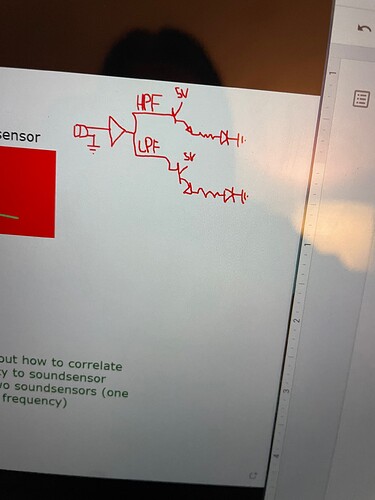
Thank you for the advice. I still think I need to follow the original schematic since my professor gave it to me. Can someone help though with writing the schematic for the HPF and LPF going from the op amp. That seems to be my trouble spot now.
The link to your "analog kit" didn't include a list of resistors & capacitors you have available.
There is that link above, showing basic RC filters (and others). The first thing to do is determine the cutoff freq.
Everything should be listed under the “What’s included” tab on the link. I think we said the cutoff frequency for the LPF would be less than 200 hertz and the HPF would be greater than 1 kiloHertz. This was relative to like bass sounds and high sounds. After typing this I’m not even sure if that is the correct way to calculate the cutoff frequency.
It isn't, but if you peer closely at the photograph of the closed lid of the kit, the discrete components are listed there.
The cutoff frequencies you provided there, can't be "calculated" as they seem to be more of a specification based on your desired application. The actual calculation would be to determine appropriate component values.
There is some unfinished business, from reply #3. I also think this is very important, it would not only clarify your intentions for us, but also for yourself. It's too easy to get carried away with a lot of yadda yadda.
The schematic that you did supply, is only a thumbnail sketch, and misleading at that.
So I can start fresh because it does seem like my intentions may have been mumbled in this forum. I have a final project and the goal was to set up the microphone (sound sensor) and have it hooked up to a op amp which would then be connected to a low passing filter and high passing filter. The LPF would sort through lower bass sounds which would then make a Red LED light glow. The HPF would sort through high-frequency sounds and light up a Green LED. A song will play to the mic which is how the sound travels. I am not sure how to construct the LPF and HPF coming (a schematic would be greatly appreciated). There would be a transistor from the filters to the resistors because I want to amplify the sound. I am not sure how to calculate the frequency cut-off or which resistors to use. From my professor's advice, I should use the Op-amp 27, transistor 2N3904. I hope this clears up the main purpose of this circuit.
I don't want to get too preachy, but isn't the point of such a final project to exercise the skills that you've learned, and show that you know how to do research to solve a problem? You've already posted diagrams of LPF, HPF so you must have some idea. I, myself, have perused the Wiki pages on filters many times... and that is not the only resource. Again, I don't want to appear too hostile or personal, but this is not a good situation in which to be asking for information that you can look up. Really, also, to convey enough information about filters in a forum format is simply impractical.
Also, you can pretty much discount the advice of a prof that steers you to an op amp that isn't rail to rail, when there is one in your kit.
You say you're unable to calculate the frequencies. Why? Did you not complete some kind of electronics training there? If you've been thrust into an unfair situation you have my sympathy but even so you could research it on your own, the math is presented along with the information on filters in hundreds of online resources explaining filters. It is really basic electronics, the project isn't a really challenging one for a tech school undergraduate.
The YouTube you link explains this.
That op-amp is a split supply amplifier, you said an Arduino was involved, use a single supply op-amp like the AD8542.
One more thing. You actually have a choice to make - between passive and active filters. That also will be explained on the Wiki site and others.
Thank you for that advice. I saw a diagram of the AD8542 and it makes more sense to use that rather than the Op 27.
This topic was automatically closed 180 days after the last reply. New replies are no longer allowed.